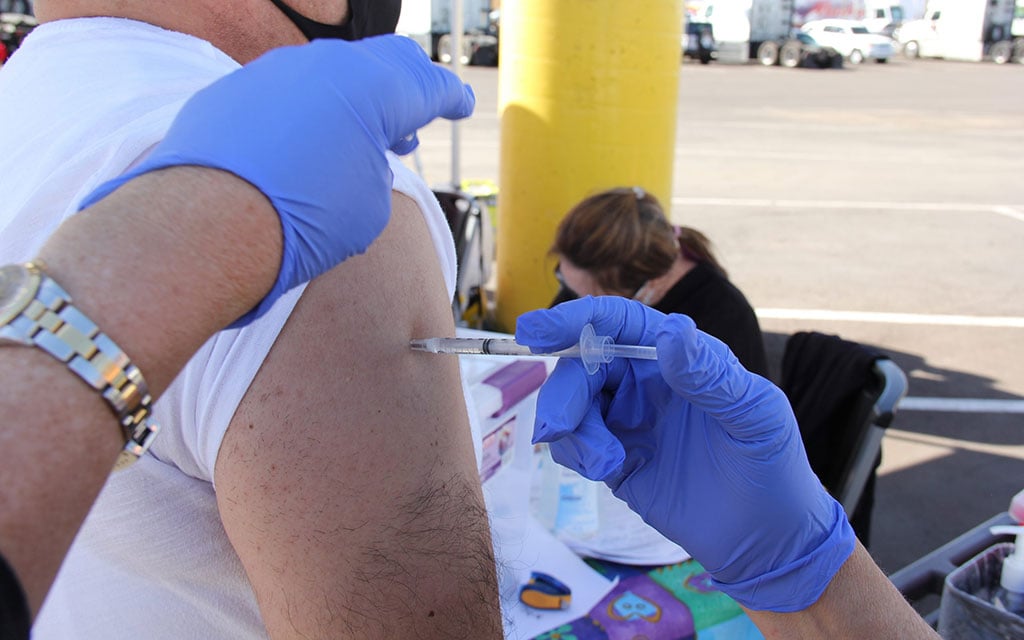LOS ANGELES – As COVID-19 is expected to surge this winter, communities across the Southwest face rising hospitalizations and new, resilient variants. Infection rates can be even more severe for marginalized populations in these states.
Limited health-care access and historically low vaccination rates amplify the burden on these communities and underscore long-standing health disparities. Following a summer surge, this new wave serves as a stark reminder of how these inequities continue to put vulnerable groups at greater risk.
The Los Angeles County Department of Public Health is deploying mobile vaccine clinics to bring updated Moderna and Pfizer shots directly to high-risk areas.
Meanwhile, the Latino Coalition for a Healthy California (LCHC) continues to lead efforts on the ground through its network of “promotores” for Latino and Indigenous individuals. These community health workers help increase vaccination rates and provide essential health education.
Mar Velez, LCHS director of policy, spoke about the high stakes for families in these vulnerable areas.
“At the height of the pandemic, a lot of Latino and Indigenous workers were still going into work, still having to go in person. … Many of us are the sole provider of our families, and so we need to show up to work. It’s very much a similar situation now where folks are going into work, facing person-to-person interactions, and those infections are impacting us disproportionately,” Velez said. “We’re the ones that are out there on the front lines. The likelihood of us becoming infected is that much greater. We don’t have the luxury of staying at home.”
Several factors are expected to drive a winter surge in the Southwest, including the circulation of new variants like KP.2 and KP.3. Though more contagious, they are not particularly severe.
The week of Aug. 10, the percentage of U.S. individuals testing positive for the virus reached its highest point since January 2022, according to the Centers for Disease Control and Prevention.
Cases, emergency department visits and hospitalizations for COVID-19 are currently declining nationally, with a positivity rate of 3.8% in California, Arizona and Nevada on Nov. 9.
The CDC’s epidemic trend modeling suggests that COVID-19 cases are likely increasing in California and Arizona. These trends are based on data from emergency department visits and provide insights into whether infections are growing or declining at the state level.
Though death rates are down, experts say the statistics are still alarming and that in marginalized communities, the illness never really left.
“Latino and Indigenous communities are still feeling the impacts and the consequences of the pandemic. … Those infections and hospitalizations that are happening now are impacting communities of color, Latino … and Indigenous communities disproportionately,” Velez said.
Health disparities in marginalized communities are rooted in systemic factors such as discrimination and unequal access to social resources such as housing, education and employment. These inequalities lead to higher rates of chronic diseases and limited health-care access, while cultural, language and trust barriers worsen the challenges.
To address these disparities, the county public health department’s Mobile Vaccine Team organizes pop-up clinics in areas of “high need, prioritizing seniors, people experiencing homelessness, and those without health insurance,” according to a media representative from the county.
Between October and December last year, the team facilitated 3,643 events and administered over 31,000 vaccine doses at no cost. This year, 338 free mobile vaccine events are scheduled, along with in-home appointments for residents who are unable to visit vaccination sites.
Additionally, the county offered back-to-school clinics in underserved areas to provide updated COVID-19 and flu shots.
Arcenio López is the executive director of the Mixteco/Indígena Community Organizing Project (MICOP). The organization provides essential services and works closely with marginalized communities, including migrant populations.
He highlighted the longstanding funding disparities community-based organizations face. These groups, which have long advocated for financial support for programs that serve marginalized communities, often see funding only in response to crises like the COVID-19 pandemic.
“For years, we’ve been saying there’s these organizations who need financial support to develop programs, to do these initiatives, to do outreach and education. Those CBOs (community-based organizations), nonprofit organizations and groups that are doing the work are always the last to receive funding,” López said. “When we (ask for) government grants, they say there is no money. But, interestingly, when COVID happened, everyone was trying to send money to organizations.”
Marginalized communities often struggle with distrust toward outsiders, particularly in health-care settings. This mistrust, heightened during the pandemic, created challenges for health initiatives. Many hesitated to engage with health services due to a history of exploitation and communication barriers.
López’s and Velez’s organizations address this by relying on trusted community members who share the same language and experiences as the people they serve.
These peer-to-peer models have proven effective in overcoming resistance and improving receptivity to health initiatives, particularly vaccinations, by cultivating trust in a way outsiders cannot.
A study by LA-based nonprofit Cedars-Sinai found that COVID-19 vaccinations significantly reduced disparities in disease incidence between low- and high-income communities in Los Angeles. Although lower-income communities initially had lower vaccination rates, the impact of vaccination was more significant and helped reduce income-related disparities.
“Everything we do at LCHC is informed by and requires community participation. … Without the participation of our communities, then it’s not as effective,” Velez said. “Policy work is never perfect, but it’s even less perfect if we don’t have impacted voices at the table. We cannot design policy solutions without the participation of our community because we often … get it wrong (or) we’re not able to address the issues that are most important to our communities. It is at the heart of what we do.”

